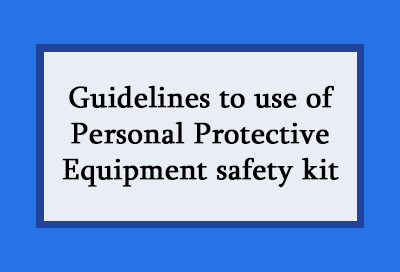
Personal protective equipment kit is utilized by healthcare providers to shield themselves from injury or contamination during an emergency. Personal protective kit is a piece of the Centers for Disease Control and Prevention's authentic Standard Precautions (otherwise called Universal Precautions). With some clinical items hard to come by demands have developed that every single clinical expert, including veterinarians, conserves PPE (personal protective equipment) until supplies become all the more promptly available.
Postponing elective methodology that requires the utilization of PPE safety kit bag is one method for conserving. Conservation procedures can also incorporate securely extending the utilization of disposable PPE, re-utilizing disposable PPE, or expanded utilization of washable PPE. Direction has been created to control personnel exposure to occupational hazards using a sequential order to accomplish suitable and effective controls. Various control procedures might be executed simultaneously, consecutively, or both to limit exposure.
Some Useful Personal Protective Equipment Kit Guidelines
The Personal protective equipment kit is a clothing and equipment worn by representatives, students, contractual workers or guests to shield or protect their bodies from work environment risks. The following items are standard issue for medical workers:
1. Hand Cleaners
The most ideal approach to prevent the spread of the malady is to wash hands with cleanser and warm water after each contact with a medical patient. Unfortunately, cleanser and water are not always available. Ensure your medical supplies or first aid kit incorporates an alcohol-based hand sanitizer.
2. Gloves
Exam gloves come in three regular sorts: latex, nitrile, and vinyl. Numerous individuals create allergies to the protein found in latex; nitrile and vinyl are significantly more hypoallergenic. According to WHO (World Health Organization) rules, utilizing gloves doesn't mean you can ignore hand cleanliness. COVID-19 disease can happen by means of glove defects or while evacuating dirtied gloves. Whenever possible, wash your hands before or after when wearing gloves.
3. Face Masks
Blood or other conceivably infectious materials sprayed or sprinkled in a rescuer's face can enter the mouth or nose and spread a disease. Utilize a face mask at whatever point body liquids may get airborne.
4. CPR Masks
Many lay rescuers would prefer not to play out the rescue breathing piece of CPR (Cardio Pulmonary Resuscitation) without a mask. One of the most widely recognized CPR masks is a level plastic barrier that lays over the casualty's mouth and nose, with a gap in the centre to permit air through. These sorts are easy to utilize, portable, and handily fit in a medical aid pack.
5. Eye Protection
Plastic glasses or goggles are the most advantageous kind of eye security for lay rescuers. Glasses frames will shield from both disease and injury. Clear plastic face masks additionally give eye protection, however just against fluids.
6. Sharp Container
Contaminated sharps, for example, needles and blades must be saved into a puncture-proof container. Use alert taking care of contaminated points and edges. These compartments protect sanitation labourers as well as other rescuers from injury.
7. Gowns
Full-body outfits are not utilized all the time outside of the hospital, yet lay rescuers can keep a crisis outfit in an emergency treatment pack or cover themselves with additional attire in a pinch.
Types Of Personal Protective Equipment
The Personal protective equipment kit can be considered in the accompanying categories, based kind of protection managed by the equipment:
1. Hearing Protection:- for example, ear muffs and plugs
2. Foot Protection:- for example, shoes/boots
3. Head Protection:- for example, helmets, caps, hoods and hats
4. Hand Protection:- for example, gloves and barrier creams
5. Skin Protection:- for example, hats, sunburn cream and long sleeved clothes
All healthcare home equipment ought to be securely structured and built, and ought to be kept up in a perfect and safe place. It should fit serenely, encouraging labourer use. If the personal protective equipment kit doesn't fit appropriately, it can have the effect between being securely secured or hazardously uncovered. Because PPE prevents contact with an infectious agent or body fluid that may contain an infectious agent, by making a barrier between the potential infectious material and the health care worker.